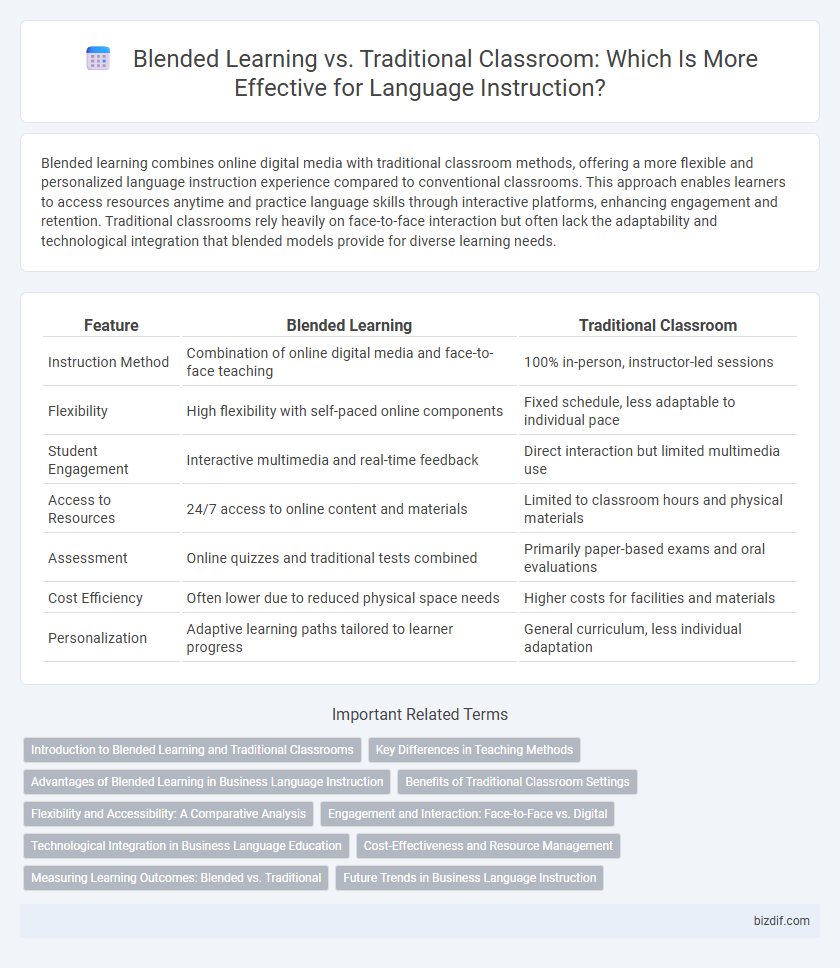Blended learning combines online digital media with traditional classroom methods, offering a more flexible and personalized language instruction experience compared to conventional classrooms. This approach enables learners to access resources anytime and practice language skills through interactive platforms, enhancing engagement and retention. Traditional classrooms rely heavily on face-to-face interaction but often lack the adaptability and technological integration that blended models provide for diverse learning needs.
Table of Comparison
| Feature | Blended Learning | Traditional Classroom |
|---|---|---|
| Instruction Method | Combination of online digital media and face-to-face teaching | 100% in-person, instructor-led sessions |
| Flexibility | High flexibility with self-paced online components | Fixed schedule, less adaptable to individual pace |
| Student Engagement | Interactive multimedia and real-time feedback | Direct interaction but limited multimedia use |
| Access to Resources | 24/7 access to online content and materials | Limited to classroom hours and physical materials |
| Assessment | Online quizzes and traditional tests combined | Primarily paper-based exams and oral evaluations |
| Cost Efficiency | Often lower due to reduced physical space needs | Higher costs for facilities and materials |
| Personalization | Adaptive learning paths tailored to learner progress | General curriculum, less individual adaptation |
Introduction to Blended Learning and Traditional Classrooms
Blended learning integrates digital tools with face-to-face instruction, enhancing language acquisition by providing flexible access to multimedia resources and interactive activities. Traditional classrooms rely on direct teacher-student interaction, promoting immediate feedback and structured learning environments for language mastery. Both methods support foundational language skills, but blended learning offers increased adaptability to diverse learner needs.
Key Differences in Teaching Methods
Blended learning integrates digital tools with face-to-face instruction, allowing personalized pacing and interactive content, while traditional classrooms emphasize direct teacher-led lessons and real-time feedback. In blended environments, technology facilitates asynchronous learning and diverse multimedia resources, contrasting with the uniform, synchronous approach typical in traditional settings. Assessment methods in blended learning often include online quizzes and analytics, enhancing data-driven insights compared to conventional paper-based tests.
Advantages of Blended Learning in Business Language Instruction
Blended learning in business language instruction enhances flexibility by combining online modules with in-person practice, allowing professionals to learn at their own pace while applying language skills in real-time scenarios. This approach increases engagement through multimedia content and interactive exercises tailored to industry-specific contexts, improving retention and practical communication. Cost efficiency and scalability are also key benefits, enabling corporations to provide consistent language training across global teams without the limitations of traditional classroom schedules.
Benefits of Traditional Classroom Settings
Traditional classroom settings offer immersive face-to-face interaction that enhances real-time communication skills and immediate feedback from instructors. Structured schedules and in-person social dynamics promote discipline and collaborative learning, fostering deeper engagement with language materials. Physical presence in a classroom environment also minimizes distractions, supporting consistent practice and retention of language concepts.
Flexibility and Accessibility: A Comparative Analysis
Blended learning offers enhanced flexibility by combining online resources with face-to-face instruction, allowing learners to access materials anytime and anywhere, unlike traditional classrooms constrained by fixed schedules and locations. This model supports diverse learning paces and styles, increasing accessibility for students with varying needs or commitments. Educational institutions adopting blended learning report higher engagement and retention rates due to its adaptable and accessible nature.
Engagement and Interaction: Face-to-Face vs. Digital
Blended learning enhances engagement and interaction by combining face-to-face instruction with interactive digital tools, enabling personalized feedback and collaborative activities beyond the physical classroom. Traditional classrooms rely primarily on direct, synchronous communication and immediate interpersonal cues, fostering real-time discussions and group dynamics. Digital platforms in blended settings leverage multimedia resources and asynchronous interaction, increasing student participation and accommodating diverse learning styles.
Technological Integration in Business Language Education
Blended learning in business language education leverages digital platforms and interactive software to enhance language acquisition through real-time feedback and multimedia resources. Traditional classrooms rely primarily on face-to-face instruction, limiting access to adaptive technologies that personalize learning experiences. Incorporating technological integration in blended models increases engagement and supports diverse learning styles, leading to improved business communication skills and greater learner autonomy.
Cost-Effectiveness and Resource Management
Blended learning reduces overall costs by combining online resources with in-person instruction, minimizing the need for physical classroom space and printed materials. Traditional classrooms often incur higher expenses due to fixed infrastructure, utilities, and material losses, limiting budget flexibility. Efficient resource management in blended models allows institutions to scale language programs while optimizing funding allocation and staff deployment.
Measuring Learning Outcomes: Blended vs. Traditional
Measuring learning outcomes in blended learning versus traditional classroom settings reveals significant differences, with blended learning often leading to higher student engagement and improved retention rates due to its interactive and flexible nature. Studies indicate that blended learning environments facilitate better skill application and critical thinking development by combining digital resources with face-to-face instruction. Traditional classrooms, while effective in structured knowledge delivery, may show slower progress in personalized learning gains and adaptability compared to blended approaches.
Future Trends in Business Language Instruction
Blended learning integrates digital tools with face-to-face instruction, enhancing flexibility and accessibility in business language training. Advanced technologies like AI-driven language platforms and virtual reality simulations are shaping future trends by providing personalized learning experiences and real-time practice. Traditional classrooms may evolve to incorporate these innovations, fostering more interactive and adaptive business language instruction.
Blended learning vs Traditional classroom Infographic

 bizdif.com
bizdif.com